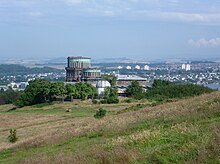Regius Professor of Astronomy (Edinburgh)
The Regius Professor of Astronomy is a 1785 as a Regius Professur of Practical Astronomy by George III. founded Regius Professorship for Astronomy at the University of Edinburgh .
In addition to this professorship, there is another Regius Professorship for Astronomy at the University of Glasgow .
History of the professorship
introduction
Astronomy has been taught at the University of Edinburgh since it was founded in 1583. Portable devices were used and there was no permanent observatory . All attempts to set up failed by the end of the 18th century. In 1822, the observatory was given the royal charter and subsequently performed functions for the university and the crown.
Foundation of the professorship
The Regius Professorship in Practical Astronomy was introduced and Robert Blair was appointed. However, Blair had neither an observatory nor adequate instruments. In addition, Blair was a medic and navigator and continued to make contributions on these topics. So he did not give lectures and concentrated on theoretical research. After Blair's death in 1828, it was therefore decided not to fill the chair until an observatory was available.
After establishing the observatory on Calton Hill, Thomas James Henderson was appointed Regius Professor. The title of Astronomer Royal for Scotland went hand in hand with the management of the observatory . This rule was maintained until 1990 after the move to Blackford Hill (1896). Since 1990, the Astronomer Royal has been an honorary position no longer associated with the Royal Observatory. Despite the instruments now in place, Henderson did not give any lectures.
Start of teaching
Only the third holder of the professorship, Charles Piazzi Smyth , also taught astronomy for students and carried out research on an international level. However, teaching suffered under the research and at the end of Smyth's professorship the observatory was in poor condition. It was Ralph Copeland who introduced structured teaching with hands-on exercises.

In 1893, astronomy was assigned by the Faculty of Arts to the newly established Faculty of Science and the addition "practical" was deleted from the name. Copeland followed Frank Watson Dyson in 1905 , who returned to the Greenwich Observatory after five years . The sixth professor, Ralph Allen Sampson , improved both teaching and research at the chair.
Modern times
In 1938 William Michael Herbert Greaves took over the chair. The outbreak of World War II stopped all research at the institute. Theoretical physics was also included in the curriculum in the following years . In 1957, Hermann Brück , a foreign astronomer, took over the chair for the first time.
owner
| Surname | name suffix | from | to | annotation |
|---|---|---|---|---|
| Robert Blair | FRSE | 1785 | 1828 | |
| vacant | 1828 | 1834 | ||
| Thomas James Henderson | FRS, FRSE | 1834 | 1844 | Henderson determined the distance to a star based on his previous measurements. However, Friedrich Bessel had anticipated him in 1838 by determining the distance to 61 Cygni, although Henderson's measurements were older than Bessels. |
| Charles Piazzi Smyth | FRSE | 1845 | 1888 | Smyth had never attended university, but his diverse skills and interests made him a good teacher. On an expedition to Tenerife , he demonstrated the advantages of altitude observation for astronomy. |
| Ralph Copeland | FRSE | 1889 | 1905 | |
| Frank Watson Dyson | FRS, FRSE | 1905 | 1910 | |
| Ralph Allen Sampson | FRS, FRSE | 1910 | 1937 | |
| William Michael Herbert Greaves | FRSE | 1938 | 1955 | |
| Hermann Brück | FRSE | 1957 | 1975 | |
| Vincent Cartledge Reddish | 1975 | 1980 | ||
| Malcolm Sim Longair | 1980 | 1990 | ||
| vacant | 1990 | 1994 | ||
| Andrew Lawrence | 1994 | today |
Individual evidence
- ^ A b Roger L. Emerson (2008) Academic Patronage in the Scottish Enlightenment: Glasgow, Edinburgh and St Andrews Universities ; Edinburgh University Press; Edinburgh; ISBN 978-0-7486-2596-3 .
- ↑ a b c d e f g h i j k l m n o Bryn Jones; Some Historical Astronomical Posts in Britain and Ireland ; Retrieved April 29, 2016.
- ↑ a b c d e f g h i j The History of the Royal Observatory Edinburgh on the website of the Foundation for the Royal Observatory in Edinburgh; Retrieved April 29, 2016.
- ↑ a b c d e f g h i j k l m n o p q r s Our History: Astronomy on the University of Edinburgh website; Retrieved April 29, 2016.